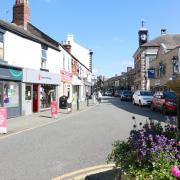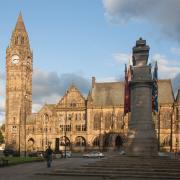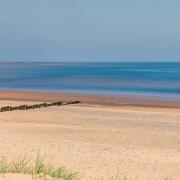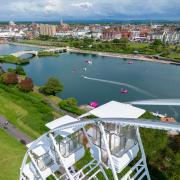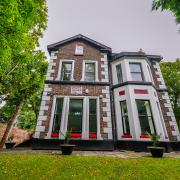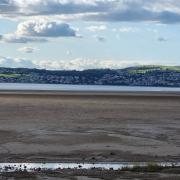This is one of Lancashire’s most affluent areas – a fact reflected in its stylish independent shops, wide avenues and many bars and restaurants – and although they are often mentioned in the same breath, Lytham and St Annes are actually two separate towns. Lytham is the older – it gets a mention in the Domesday Book – while St Annes was established in the late-19th century, when sea bathing holidays were becoming popular.
The picturesque Lytham windmill has become an iconic image. Situated on The Green, it is now a four floor museum, exploring the history of the area. Next door is The Old Lifeboat House, housing a 1901 lifeboat. Lifeboats have always been important here and the modern Lytham St Annes Lifeboat Station has two boats: one housed in Lytham and one in St Annes. To mark the RNLI’s 200th anniversary this year, there is the chance to replace, for a donation, one of the 700 pavers outside the St Annes Station with a personalised engraved one.

Lytham Hall, a stunning Georgian house, is a perfect place to spend an afternoon. Open six days a week, it is full of elegant and interesting items. The hall is surrounded by 78 acres of parkland – great for children and dogs – including The Mount, the highest point in Lytham. There is also an animal hub, a plant centre and an antiques and reclamation centre. There is also a splendid tearoom where you can recharge your batteries. The Hall also holds a wide variety of events throughout the year. The Classic and Performance Motor Show takes place on May 19 and the Proms Concert is on August 25.
Not far away is Witch Wood, a Site of Special Scientific Interest, with indigenous trees and plenty of wildlife. However, despite its name, you won’t see any witches riding broomsticks. The Witch was the name of a racehorse once owned by the Clifton Family of Lytham Hall. You can find the grave marker if you look hard enough.
There are lots of restaurants, cafes and pubs in both towns – and at Fairhaven and Ansdell, the villages which sit between them – some great shops and plenty for people of all ages to enjoy.

Harping on
‘There’s been a revival of interest in the harp, and a lot of that is down to King Charles, who promotes it and even has his own harpist,’ says Nicole Adshead of Coastal Harps.
Nicole, a fully trained professional musician, first yearned for a harp when she was taken as a child to see, The Nutcracker.
‘I didn’t get one. It was expensive, the nearest teacher was in Wales and I don’t think my parents would have relished getting me and my harp on and off a coach. I did train as a musician though – with the clarinet, the saxophone and the piano but eventually, as an adult, I studied the harp. I had an estate car by then,’ says Nicole, who now has eight harps.
‘They can be expensive. The king’s harp cost over £100, 000 but today, you can buy a small harp for £100 and I have a selection that I bring to my courses for people to try,’ says Nicole whose harp courses are popular with all ages.
‘It’s meditative, so great for mental health, you don’t need any prior knowledge, it helps with arthritis and it’s fun,’ says Nicole whose students range from seven to 80.
Nicole is also in demand as a wedding harpist. ‘I’ve played in hotels, stately homes, woods and on the beach. It’s such a romantic instrument: a song that brides love to hear on it is Ed Sheeran’s, ‘Perfect’. It looks good and when you’ve got it to where it’s going, it doesn’t need much space.’
And Nicole adds: ‘It’s associated with all the countries of the UK but I can’t help feeling the harp should be Lancashire’s signature instrument, as our damp climate suits it perfectly.’

Bend like willow
Willow sculptor, Helena Mellenchip, thinks Lancashire is one of the best places to be a willow sculptor.
‘Willow likes our climate – too much heat can really spoil it and when you consider that each foot of willow takes a day to prepare, every little bit helps,’ says Helena who, nonetheless has huge soaking troughs in her studio.
‘People like to have sculptures made of willow, especially as we are all aware we need to be as sustainable as possible. The willow I use comes from coppiced trees that may be centuries old.
Helena’s skill has led to her receiving many public commissions. They include a charity that commissioned a giant fox in Preston to the Ansdell in Bloom group who commissioned a sculpture of painter Richard Ansdell – after whom the area was named – to stand outside the library.
‘I’m currently working with Lytham Hall as next year, eight of my giant animal sculptures will be displayed in the grounds. They’re pretty popular with private buyers too, I recently delivered a willow elephant and her calf to a private garden, albeit a pretty large garden.’
Helena also makes smaller animals too – sometimes replicas of actual pets – and green domes: garden shelters made of willow that grows naturally and look beautiful.
‘I love running courses too,’ she adds. ‘It’s good to see people’s faces when out of a tangle, something real and tangible emerges. Willow is an amazing material and I’m on a mission to make sure everyone knows that.’

Bear hugs
Lorraine Wragg of Ansdell Teddy Bears – a teddy bear hospital – is in no doubt about what she would rescue in the event of a house fire. It would be her 2000 teddy bears and she even has a strategically placed trampoline to catch them from the upstairs windows. Not surprising for someone who was in charge of bears at St Annes Toy Museum,
Battered teddies make their way to her every day from all over the country, to take advantage of her eight sewing machines and massive collection of body parts. But do teddies lead such dangerous lives that they need hospital treatment?
‘Well, some do! Dogs rip them and some contract moth infestations. A common danger is going through a boil wash. A famous singer arrived with the remains of his teddy in two carrier bags with stuffing everywhere. The stuffing had also clogged up his washing machine but he got no sympathy for that,’ says Lorraine who recommends a damp wipe with Fairy Liquid.
‘Many teddies though have just had long lives and need an MOT: washing, replacing pads, eyes and growlers. People also like to have a childhood teddy restored as a gift,’ adds Lorraine who has a collection of thank you cards from teddies who have been rescued.
‘Sometimes, people ask me to track down a teddy from their youth or to make them a replica and that’s fun. There’s a trend at the moment for dressing teddies in a child’s christening outfit and I’m also working on perfecting magnetic paws that can hold an engagement ring. It can be easier to propose when you have a teddy to help you.’
4 THINGS TO DO IN LYTHAM ST ANNES
![Great British Life: The St Annes Old Links course. Great British Life: The St Annes Old Links course.]() The St Annes Old Links course. (Image: Kirsty Thompson)
The St Annes Old Links course. (Image: Kirsty Thompson)
Golf
St Annes Old Links is regularly voted among the top 100 English golf courses, as is nearby Fairhaven. Lytham Green Drive was designed by the same chap who designed Royal Melbourne. Best known though is Royal Lytham and St Annes, one of the world’s best links courses which has hosted The Ryder Cup and The Open Championships. And you can stay in its Dormy House, overlooking the first tee.

Fairhaven Lake
Experience this saltwater lake by hiring a boat, learning a water sport or by enjoying the many land activities, like tennis, bowling or the skate park. Or simply take a stroll around the lake and the Japanese gardens which are being restored. There’s a cafe and an RSPB Visitor Centre too, as well as a Spitfire Memorial. On May 18, the lake is hosts a spectacular Dragon Boat Festival.

The Beach
You can’t go to the seaside without going to the beach and the beach at St Annes is well worth the risk of getting sand in your sandwiches. Described as a ‘huge expanse of golden sand’ by the UK Beach Guide, it has a Victorian pier, donkeys, and picturesque beach huts to hire. It can be a long walk to the water’s edge when the tide is out, but on a clear day you’ll be rewarded with views to the Lakland fells, the mountains of North Wales and the Pennines.

A walk in the parks
Lytham Green offers views across the Ribble Estuary and hosts the Lytham Festival in July. The award-winning Lowther Gardens is home to the Lowther Pavilion, with its lively entertainment programme. In St Annes, Ashton Gardens is also worth a visit – it's 150 years old this year and has glorious flowers beds, an ornamental lake and a good cafe. In the Peace and Happiness Garden near the pier, there’s a statue of Les Dawson who lived nearby.
THREE PLACES TO STAY

Clifton Arms, Lytham
A four star independent family run hotel with stunning views across the seafront and stylish contemporary interiors. Bedrooms are tastefully presented and the AA Rosette restaurant has a super reputation. Top-notch afternoon teas are also served.

The Grand, St Annes
A luxury spa hotel, offering a swimming pool, hot tubs, sauna, gym and a range of spa treatments: many using local honey and beeswax. The restaurant, the Café Grand, has British and European influences and fosters a cosmopolitan atmosphere.

The Queens, Lytham
With views over Lytham Green, it was the town’s first hotel to have baths with indoor plumbing. Today, it is a pub offering classic British dishes with a range of accommodation, including a suite with a four poster.







